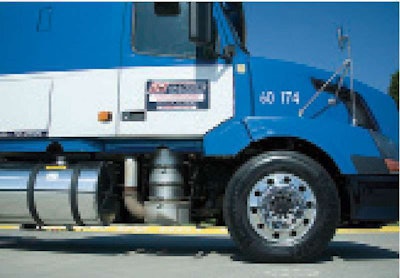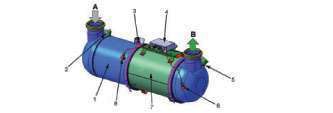While the diesel particulate filter itself requires little maintenance, proper attention to related systems will help avoid problems.
 The compact Volvo and Mack DPF fits comfortably behind the step on the passenger side door.
The compact Volvo and Mack DPF fits comfortably behind the step on the passenger side door.The U.S. Environmental Protection Agency’s 2007 emissions standards required a reduction in both diesel particulate and nitrogen oxides. The new particulate standard was so low that, even with advanced injection and air handling systems, a particulate filter was needed to bring exhaust soot levels down to required levels.
The porous ceramic filter under normal, over-the-road driving conditions burns off the soot it collects and does not require frequent maintenance. However, it still has to be cleaned periodically because some ash ends up in the filter.
“The regeneration of soot in the DPF does not form ash buildup or any residue in the DPF,” says Zack Ellison, director of customer technical support at Cummins. “Ash collected in the DPF is primarily caused by sulfated ash (TBN) in the oil.” Ash, which results from burning of a small amount of lube oil, does not burn, even at temperatures that burn off soot, and must be cleaned up.
While certain specific DPF-related maintenance tasks are required, both the vehicle’s maintenance and its operation have a significant effect on DPF performance. Therefore, running a 2007 or later model truck will keep you on your toes. The payback could be lower costs since your equipment will last longer, run better and fetch a higher resale value.
While the filter burns off soot as fast as it collects under normal highway driving conditions, soot will accumulate during idling or while crawling through traffic. In response, you have to actuate a fuel dosing system to clean the DPF, a process called active regeneration. Warning lamps on the dash will indicate the need for active regeneration or ash cleaning. Which lamp turns on depends on how fast backpressure is building up in the DPF, as soot accumulates much faster than ash.
You need to allow the DPF to go into active regeneration mode whenever practical. Prevent regeneration, however, when the vehicle is entering a shop or an enclosed environment where a super-hot DPF would not be safe.
 TIn the Cummins particulate filter the diesel oxidation catalyst is at left and the ceramic filter at the center.
TIn the Cummins particulate filter the diesel oxidation catalyst is at left and the ceramic filter at the center.DPF regeneration helps ensure exhaust backpressure does not rise to the point where fuel economy is reduced. So, “if needed, induce an active regeneration when prompted by the warning lamp,” says Mike Kalkoske, quality services manager for Kenworth.
Another concern is recognition of turbo failure. “The DPF does such an efficient job of exhaust-out particulate removal that the previous symptom of a turbo failure – lots of exhaust smoke – no longer shows up,” says Mack’s David McKenna, director of powertrain sales and marketing. “At the very first symptom of a turbocharger failure, which is an almost instant loss of power with turbine/compressor wheel noise, the engine must be shut down.”
The consequences of not doing this can be dire. McKenna says, “If the failure is contained within the first few moments, then DPF damage will be somewhat mitigated. Small amounts of engine lube oil can be force-regenerated off.” But if operation continues more than a few minutes, the accumulation in the DPF will be so great that it will require “replacement of both the DPF catalyst and the actual filter as well,” he says.
On-board diagnostics may help prevent some of the potential problems that might cause secondary DPF damage, but “there are still failure modes that OBD does not catch that would cause it to be damaged,” says Amanda Phillips, manager for product planning for Detroit Diesel. “A turbo losing its oil or an engine leaking coolant are two examples.”
Drivers need to be aware of unusual sounds, power loss, a loss of coolant from the radiator (especially when accompanied by a rising temperature indication) or high oil consumption. Any of these require immediate attention.
“Detroit Diesel also recommends seeking immediate support for any indication of engine malfunctions,” Phillips adds. “The fuel and air systems are especially important to the longevity of the DPF.”
Truck application affects maintenance, says Brad Everett of Caterpillar Global On-Highway. “Applications with low-load factors or high-idle times may shorten the cleaning interval life,” he says.
The reason is that a diesel engine’s piston rings don’t seal properly under light loads because cylinder pressure is lower. This increases oil consumption and the amount of ash sent into the DPF. To minimize those, limit idling and avoid stop-and-go and slow driving conditions if possible. n
Maintenance tips
Wear resulting from the use of inferior lubes, excessively long oil change intervals or cooling system neglect will increase ash in the DPF and the frequency of ash cleaning.
Zack Ellison of Cummins says it’s primarily ash in the oil that necessitates cleaning the DPF. Since engine oil consumption is the most basic consequence of normal wear, one way to minimize maintenance required to keep the DPF free of ash is to do all basic engine maintenance religiously.
Poor maintenance may also get you in trouble because of exhaust soot. “A complete PM program is recommended to help ensure that the engine, in general, is protected and running properly,” says Kenworth’s Mike Kalkoske. “Premature engine wear due to poor oil change intervals and failure to maintain the air intake system may result in more soot out the exhaust than the DPF will have the ability to burn off. This may also lead to more frequent DPF cleaning.”
A clogged air cleaner, neglect of the overheads or a charge air cooler leak or outside blockage could reduce airflow into the engine and result in higher than normal levels of particulate from unburned fuel, and the need for frequent regeneration. Another cause of frequent regeneration is the particulate generated directly due to engine wear, which increases oil consumption and soot from the incompletely burned oil, while also reducing compression and combustion efficiency. The only solution for this problem is an overhaul.
ASH CLEANING. Partial clogging of the DPF with ash will not produce enough backpressure to have a significant effect on fuel consumption. However, Mack’s David McKenna and Kalkoske say ash could affect fuel economy by hampering the ability to burn off soot. McKenna says, “The first indication of a full ash load is the increased frequency of active regeneration events, which is caused by the lack of space within the filter to trap particulate.”
Always clean out the ash when you get an indicator light. Clean at the specified interval until experience shows the DPF is accumulating minimal ash.
CHOOSING YOUR LUBE. Using the oil that meets the manufacturer’s requirements is critical, not only to minimize engine wear but to minimize the amount of ash each quart burned will put into the DPF. Industry experts support use of the newer CJ-4 oils, including Cummins, the one engine manufacturer that allows use of CI-4 oils with DPFs. Ellison says, “Cummins has allowed for the use of either CI-4 or CJ-4 oils with EPA-07 engines. This is the same for our 2010 products. While CJ-4 oil is not mandatory for use in EPA 2010 ISX15 or ISX11.9 engines, it is recommended so as to optimize the maintenance interval for the diesel particulate filter.”
While all CJ-4 certified oils are extremely low in ash, you also have the option to shop for oil by looking for the lowest total weight of ash. Detroit Diesel’s Amanda Phillips says, “Low ash content by weight is important to the performance of the engine as it relates to ash accumulation.”
FUEL FILTERS. Phillips also says it’s important to change fuel filters at recommended intervals. When intervals are extended, it may cause trouble because of poor combustion or fuel impurities getting trapped in the DPF.
FUEL. Kalkoske says an inferior grade of fuel may contain impurities that will end up trapped like ash in the DPF.
DOSING SYSTEM. Maintain the dosing system used for active regeneration by cleaning it at specified intervals, normally 150,000 miles or one year. McKenna says coking problems experienced in many engine makes may prompt the need to install a kit Mack provides to drain the nozzle area of fuel when it’s not being used and protect its fuel line from heat. On Caterpillar engines, Cat’s Brent Cluskey says to inspect/replace the ARD spark plug that ignites the dosing fuel at 90,000 miles.
CRANKCASE VENTILATION. Maintain the onboard crankcase ventilation system according to manufacturer’s recommendations. Cluskey recommends the same interval as the spark plug. He also recommends cleaning the crankcase fumes fitting on Caterpillar mid-range engines. The OCV system separates oil from the blowby gases, thus reducing oil consumption and minimizing the amount of ash in the DPF, if properly maintained.
DPF cleaning
Engine manufacturers say ash cleaning intervals are much longer than forecast.
Cummins’ Zack Ellison says, “We are seeing very few over-the-road customers actually needing to perform a routine ash cleaning for the DPF. Many customers are running 400,000 to 500,000 miles before needing an ash cleaning.”
Caterpillar, even though its DPF with clean gas induction generates a little more exhaust, estimates intervals from 250,000 to 350,000 miles, according to the company’s Brad Everett.
Kenworth’s standard interval is 160,000-200,000 miles, while Ellison says Cummins increased its standard interval from 200,000 to 300,000 miles.
When cleaning becomes necessary, the proper procedure is essential. Detroit Diesel’s Amanda Phillips says, “Customers should take their vehicle to an authorized Detroit Diesel service location to have their original DPF exchanged with a remanufactured core unit.” Ellison says Cummins customers “can choose to wait for the cleaning while in the shop or can select to simply exchange the DPF for a Cummins ReCon Particulate Filter.”
Mack’s David McKenna says a ReMack exchange filter “saves time and money as the filter has been completely X-rayed and cleaned to the highest standard.”
On cost, Everett says Caterpillar has “a flat rate charge that varies from dealer to dealer.” Kenworth’s Mike Kalkoske says, “The cleaning time depends on the cleaning machine used, and amount of ash needing to be removed. An operator should typically expect the cleaning to take 30 minutes to an hour and cost an estimated $250 or more.”

1. Diesel oxidation catalyst
2. DOC inlet temperature sensor
3. DOC outlet temperature sensor
4. Sensor junction box
5. DPF outlet temperature sensor
6. DPF outlet pressure sensor
7. Diesel particulate filter
8. DPF inlet pressure sensor










